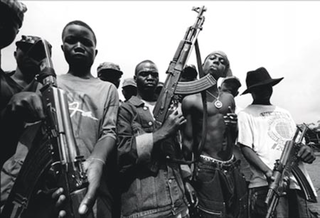 W
WThe Monrovia clashes in 1998 were the result of Liberian President Charles Taylor's attempts to violently eliminate one of his last domestic political opponents, Roosevelt Johnson, a former warlord of Krahn ethnicity. At the time, Johnson still lived with a small loyal militia in Monrovia, the capital of Liberia. After some minor armed altercations, almost all of Johnson's followers were finally killed by Taylor's security forces during a major firefight in September 1998, though Johnson himself managed to flee into the United States embassy. After one last attempt by Taylor's paramilitaries to kill him there, causing a major diplomatic incident, Johnson was evacuated to Ghana. Although the clashes were effectively a political victory for Taylor as he had removed Johnson from Liberia, the mass killings of ethnic Krahn after the clashes contributed to the outbreak of the Second Liberian Civil War which saw the president being toppled.
 W
WThe First Liberian Civil War was an internal conflict in Liberia from 1989 until 1997. The conflict killed about 250,000 people and eventually led to the involvement of the Economic Community of West African States (ECOWAS) and of the United Nations. The peace did not last long, and in 1999 the Second Liberian Civil War broke out.
 W
WLeymah Roberta Gbowee is a Liberian peace activist responsible for leading a women's nonviolent peace movement, Women of Liberia Mass Action for Peace that helped bring an end to the Second Liberian Civil War in 2003. Her efforts to end the war, along with her collaborator Ellen Johnson Sirleaf, helped usher in a period of peace and enabled a free election in 2005 that Sirleaf won. She, along with Ellen Johnson Sirleaf and Tawakkul Karman, were awarded the 2011 Nobel Peace Prize "for their non-violent struggle for the safety of women and for women's rights to full participation in peace-building work."
 W
WLiberia did not become militarily involved in World War II until January 1944, with the election of William Tubman, at which time the country declared war on Germany and Japan. However, even before the start of Liberia's official military involvement, the nation participated in the war for two years under the terms of a Defense Agreement with the United States. Apart from Ceylon and the Belgian Congo, Liberia possessed one of the few remaining sources of rubber for the Allies. To guarantee a steady supply of rubber from the world's largest rubber plantation, operated at Harbel by the Firestone Company since 1926, the US government built roads throughout the country, created an international airport, and transformed the capital, Monrovia, by building a deep water port.
 W
WThe Monrovia Church massacre, also referred to as the St. Peter's Lutheran Church massacre, was the worst single atrocity of the First Liberian Civil War. Approximately 600 civilians were killed at the church in the Sinkor section of Monrovia on 29 July 1990. The massacre was carried out by approximately 30 government soldiers loyal to President Samuel Doe. The perpetrators were of Doe's Krahn tribe while most of the victims were from the Gio and Mano tribes, which were in support of the rebels.
 W
WEbenezer Norman is a Liberian philanthropist, humanitarian, public speaker, and founder of the education non-profit A New Dimension of Hope (NDHope). He is involved in humanitarian efforts in Liberia and throughout West Africa, notably for efforts to build schools in attenuated or war-torn communities after the Second Liberian Civil War in 2003 and the Ebola virus epidemic in Liberia in 2015.
 W
WThe Second Liberian Civil War began in 1999 when a rebel group backed by the government of neighbouring Guinea, the Liberians United for Reconciliation and Democracy (LURD), emerged in northern Liberia. In early 2003, a second rebel group, the Movement for Democracy in Liberia (MODEL), emerged in the south, and by June–July 2003, Charles Taylor's government controlled only a third of the country.
 W
WWomen of Liberia Mass Action for Peace is a peace movement started in 2003 by women in Monrovia, Liberia, Africa, that worked to end the Second Liberian Civil War. Organized by Crystal Roh Gawding and social workers Leymah Gbowee and Comfort Freeman, the movement began despite Liberia having extremely limited civil rights. Thousands of Muslim and Christian women from various classes mobilized their efforts, staged silent nonviolence protests that included a sex strike and the threat of a curse.